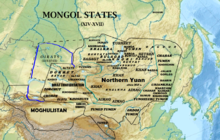Northern yuan
The Northern Yuan (Chinese: 北 元; pinyin: Běi Yuán ) initially meant a Mongolian dynasty of the Genghisids , later the title of ruler was in the foreground. In a figurative sense, it also meant the group of ruled tribes - predominantly Chalcha - and the corresponding area on the Mongolian plateau . It existed from 1368 to 1634.
Yuan Dynasty
The Mongolian Yuan Dynasty in China, founded by Kublai Khan , was proclaimed in 1271. In 1368 she was chased away by the Han Chinese Ming dynasty. The last Khan, Toghan Timur , fled north with his people, but never gave up his claims against the Ming. The ruling house was now called the Northern Yuan .
Biligtü Khan , son of Toghan Timur , succeeded him in 1370. An official seal found during excavations in Karakorum with partly Chinese and Phags-pa script proves this: Biligtü Khan traded under the name Zhaozong (昭宗 Zhāozōng) as the emperor of the Yuan.
Uskhal Khan , son of Biligtü Khan , succeeded him after his death in 1378. The Ming forces pushed in and defeated the Mongols in 1388 in a battle near Lake Buir Nur : 70,000 Mongols were captured. On the flight to Karakorum , he was the Tuul -flow of Jorightu Khan Yesüder attacked, a general of the attackers took him and his son to. They were the last of the line of Kublai Khan.
Just like before the time of Genghis Khan, the Mongolian tribes now regularly attacked the Chinese Empire again, which prompted the rulers of the Ming dynasty to further expand and strengthen the Great Wall of China . Times of war alternated with times of peace. Numerous battles among the Mongolian tribes, spurred on by China, began.
Intermediate phase
Jorightu Khan Yesüder (Mong .: Зоригт хаан, 1358-1392) took over the title of "Mongolian Khagan" from the 'Northern Yuan'.
Jorightu died in 1392, followed (probably) by his son Engke Khan , who only ruled until 1393.
Wrestling with the Oirats
1412 was the Oirats dependent Delbeg Khan Great Khan of the Northern Yuan. During this time the Oirats suffered a defeat against the Ming and Adai Khan was able to unite the eastern and then the central regions of Mongolia. In the struggle for the western, Oriental, territories he had no final success; but since the Orians had no khan for a few years, he was the only khan of the Mongols at that time. In 1425 he became Greater Khan. The Ming saw this as a threat and now again supported the Oirats. In 1430 Adai Khan suffered a decisive defeat, in 1438 he was killed by the Oirats.
Now the Oirats regained the upper hand and Esen Tayishi was able to extend his rule to the whole of Mongolia, in 1449 he invaded China, in 1453 he made himself Khan, but in the following year he was murdered.
A struggle for supremacy began, in 1475 Manduul Khan was able to prevail against most of the khans until he was murdered in 1478.
Dayan Khan
Manduul's daughter Manduchai installed her underage son Dayan Khan as the new Khan, and in the following years the Mongolian tribes were reunited. He organized the Eastern Mongols into two wings with 3 towers each, for a total of 6 towers (towers means ten thousand):
- Left wing: Khalkha , Chahar and Uriankhai (Mongol .: Урианхай, MNS: Uriankhai )
- Right wing: Ordos , Tümed (Mongol .: Түмэд) and Yöngshiyebü (a sub-tribe of the Khartschin (Mongol .: Харчин) (with Asud (Mongol .: Асуд) and Khartschin))
He left the management of the towers to his sons and grandchildren. For Khan , a descendant was always appointed his eldest son. This was first his grandson Bodi Alag Khan (r. 1524/32 / 43–1548), then his son, etc. The last of them was Ligdan Khan (r. 1603–1634). The dignity of viceroy ( Jinong ) took over successively Bars Bolod (1484-1531 / 32) and his two sons Gün-bilig and Altan . This classification related to both military and administrative aspects. Dayan's reign is seen as the high point in 1517, when he went with an army to Beijing. In 1542, shortly before his death, he defeated Chinese troops one last time.
Final phase
During the reign of Daraisung Guden Khan (1547–57) the power of the Altan Khan , who actually only led the east wing, grew . During this time, Tibetan Buddhism began to become the state religion of the Mongols. Tümen Zasagt Khan managed to unite all Mongols for the last time during his rule from 1558–92. After that, unity among the Mongols waned.
In the struggle between the two most important Mongolian tribes, the (West Mongolian) Oirats gave way to the (East Mongolian) Chalcha .
In the east, Ligdan Khan fought unsuccessfully from 1619 against the growing pressure of the Manchus under Nurhaci and Hung Tayiji . He lost the support of many East Mongolian tribes, had to flee with his tribe, the Chakhar , and died in 1634. His widow and underage sons Ejei and Abunai became pawns for various interests and fell into the hands of the Manchu. Ejei (1622–1641) gave Hung Tayiji the Yüan imperial seal - allegedly recovered through miraculous circumstances - and thus the khanate.
The Mongolian Chakhar joined the Manchurian Jurchen in the following years .
literature
- Stephan Conerman, Jan Kusber (ed.): The Mongols in Asia and Europe , Peter Lang Verlag, Frankfurt / M. u. a. 1997. ISBN 978-3-631-30636-9 .
- Michael Weiers: History of the Mongols . Kohlhammer, Stuttgart a. a. 2004, ISBN 3-17-017206-9 .
Remarks
- ↑ There are problems with his identity: Was Jorightu a descendant of Ariq Böke and Engke Khan was his son who succeeded him or were both the same person with different titles?
